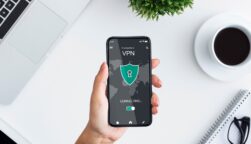In the spring of 2020, the world of work changed forever. Millions of office employees across the globe were sent packing – along with their laptops – and told to work remotely.
For many bosses and business owners, this prompted the question: can we trust employees to carry out their duties with minimal oversight from their managers?
For those that answered “no”, employee monitoring (EM) software – programs that are used to surveil staff whilst they work – became a common yet controversial solution.
We spoke to the companies that use them, and the employees that are being watched by them.
What Does Employee Monitoring Software Actually Monitor?
The least intrusive types of EM software – sometimes called staff surveillance software, ‘bossware’ or ‘tattleware’ – offer tools that allow employers to carry out task-based time tracking.
Other products are more invasive, with the ability to log keystrokes, take screenshots, detect mouse movement, monitor websites, and even take over employees’ devices remotely.
Surveilling on-shift staff is by no means a pandemic-era phenomenon – software like this has actually been around for years. Hubstaff, one of the most popular monitoring software programs, celebrates its 10th birthday in 2022.
According to New York Times correspondent Adam Satariano, Wall Street firms have been using software of this sort for some time now to mitigate security threats – the same threats that inspired Isaac Kohen to create Teramind, another leader in the employee monitoring space.
Warehouse, hospitality, and GPS-tracked delivery workers are also used to being watched closely. But the mass move to remote working as a result of the COVID-19 pandemic saw more businesses turn to this type of software than ever before.
One report found that searches for ‘Hubstaff’ were up 79% between March 2020 and June 2021; searches for ‘Teramind’ increased by 116% in the same period.
The Merits and Pitfalls of Staff Surveillance
Bosses who use EM software do so for a variety of reasons. Encouraging staff to use their time well is a popular justification.
Jonathan Tian, the co-founder of Mobitrix, uses the popular monitoring tool Teramind to track what his employees are doing during work time. He claims it “significantly improves the productivity in (his) organization”.
“It facilitates screen recordings, live views of employee PCs, tracking emails, and zoom session recording, which helps me prevent any uneven activities from employees” Jonathan explained.
Evidence compiled near the beginning of the pandemic revealed that a significant percentage of employers were unconvinced about their employees’ ability to be productive whilst working remotely.
Some of America’s most prominent business chiefs reported declining productivity during the last two years; JP Morgan’s CEO, for instance, said in 2020 that the bank had recorded productivity dips since the shift to remote working. Bosses in Europe reported similar experiences last year.
But statistics suggest that, on the whole, fears about remote working’s effects on productivity aren’t well-founded.
Great Place to Work’s survey of 715 companies, for example, compared productivity during the first 6 months of lockdown (March-August 2020) with a similar period in 2019. After assessing 800,000 responses, they found that workers actually reported productivity increases of up to 13% whilst stay-at-home orders were in place. The elimination of both commutes and lengthy, in-person meetings were cited as explanatory factors.
Productivity is, however, notoriously hard to measure, particularly amongst knowledge workers. Simple metrics like “output divided by hours worked” that are often used to track productivity in sectors like manufacturing do not map neatly onto other professions.
What’s more, plenty of criticism has been leveled at ‘lockdown productivity’ surveys – WFH means employees tend to work longer hours, so may be getting more work done whilst simultaneously being less productive.
Besides, statistics about productivity are unlikely to sway bosses seeing drop-offs first-hand. One recent survey found that executives only trusted, on average, 66% of their staff teams to get their remote working tech up and running properly. With these levels of perceived incompetency in mind, it’s no surprise that EM software usage is widespread.
However, some bosses report activating such programs and their functions only in specific circumstances.
Amit Raj, CEO of bespoke link-building company The Links Guy, says that he doesn’t “use all the features available” in his EM software “unless an employee is taking a long time to complete tasks or there are big chunks of inactivity showing.”
Amit informed Tech.co that the screenshot function was only used when a staff member was put under performance review (and were made aware of its implementation). His usage alludes to the fact that EM software is sometimes deployed as a reactionary measure grounded in genuine evidence of slacking.
“One team member was setting his timer on for work and playing video games” Raj added, “consequently, he was shown the evidence and made a swift exit!”
Studies charting the effect of EM software on productivity are scarce. One such survey by Digital.com, however, which involved 1,250 US employers, found that 81% reported an increase in productivity after the implementation of EM software.
Indeed, whilst many bosses have anecdotally reported upticks in productivity through the use of EM software, other companies have found it to have the opposite effect.
“We used EM software right in the beginning of the pandemic when we went remote, but it didn’t really work well for our business” remembers Teri Shern, co-founder of Conex Boxes.
“The problem with monitoring software is that it can make your employees feel suffocated,” Teri said. “it’s almost like having a manager constantly standing over you watching you work – it dulls productivity”.
Employees Don’t Like Being Watched at Work
Staff experiences with EM software suggest that positive experiences on the user-end are few and far between.
Emma, co-founder of pawesomeadvice.com, was monitored by superiors using Hubstaff in a previous job role.
“I think EM software is intrusive and can cause problems within a workplace and make employees disengaged and unhappy” she argued, suggesting that implementing it “tells employees that their employer doesn’t trust them and needs to micromanage their every move”.
Saurabh Wani, who was also monitored in a previous role, describes how all of his marketing activities were monitored with screenshots using Hubstaff.
“In terms of privacy, initially, I felt violated,” Saurabh told Tech.co, “but then I got used to it.”
Saurabh said that in his first week in the job, he was “ nervous and was always on [his] system”, but that the team “were supportive” and “never asked why” if set hours were not completed.
Late last year, an ExpressVPN survey of 2,000 workers found that employees, on the whole, were unhappy with surveillance measures in the workplace.
43% said it was a violation of trust, whilst 28% reported feeling underappreciated due to monitoring. 36% of employees felt they had to work longer hours due to corporate surveillance.
The feeling of “suffocation” that Shern mentioned is not uncommon either. 59% of all staff surveyed by ExpressVPN admitted that being surveilled by their bosses at work caused stress and anxiety.
Because of these employee sentiments, some bosses have been met with stiff resistance when attempting to deploy it.
Olivia Tan, co-founder of Cocofax, tells us that her company’s usage of Teramind does not amount to an invasion of privacy as it was in their “corporate handbook for employees,” despite using keystrokes as a “baseline for worker activity” and corroborating it with “corresponding screenshots, activity logs, audit trails, and all of the deeper checking vectors”.
Importantly, however, less invasive software – such as programs that track how long it takes to do certain tasks, for instance – can make employees equally uncomfortable.
One individual Tech.co spoke to, who didn’t want to be identified by name, experienced time-tracking in a previous remote role. Her company required employees to enter all their daily tasks into a program and assign a task type and duration time.
“I’d feel like I’d do my day, track my time and I’d only have 6 hours logged – despite working for longer. At one point, I asked if I needed to put in toilet breaks – I felt I had to hit the target of at least 7.5 hours a day.”
Time is not always a useful or accurate metric for tracking productivity – and it can make employees uneasy when it’s wielded as such for disciplinary reasons.
“The managers could see all the work we had planned for the day, and they sometimes went through timetables and told us tasks didn’t take as long as we said they did,” she added. “It was stressful”.
Can Employee Monitoring Ever Be Ethical?
Is there any way to remotely monitor employees without compromising their privacy or generally making them feel uncomfortable?
Reid Blackman P.h.D., CEO of ethical consultancy Virtue Consultants, suggests it is possible with high levels of communication and transparency.
“Tell your employees what you’re monitoring and why,” Blackman explains in Harvard Business Review. “Give them the opportunity to offer feedback. Share the results of the monitoring with them and, crucially, provide a system by which they can appeal decisions about their career influenced by the data collected.”
Some believe, however, that monitoring employees is inherently unethical and intrusive.
Andreas Theodorou, Content Editor of digital rights resource ProPrivacy, dubbed the software “an Orwellian nightmare” and questioned the legal basis for its continued usage.
In the US, the Electronic Communications Privacy Act of 1986 (ECPA), prohibits the “interception” of electronic communications.
“It’s clearly an outdated piece of legislation,” Andreas argued, adding that the law “does nothing to protect the digital rights of employees in the modern day”.
Karla Grossenbacher, a Partner at multi-national law firm Seyfarth Shaw and Head of the National Workplace Privacy group, pointed out that “there are all sorts of technologies that were not even contemplated when ECPA was passed that could be used by employees in their work and employers in their monitoring of this work.”
In the US, there is currently no federal law (including the ECPA) that requires employers to even notify staff that they’re deploying monitoring software.
Grossenbacher added that “employers need to be aware of their obligations under the ECPA, and know the laws of any states in which they have employees.”
In the US, there is currently no federal law (including the ECPA) that requires employers to even notify staff that they’re deploying monitoring software (although some states do require it) – which adds more weight to the idea that current legislation is inadequate.
The Stored Communications Act 196 (SCA), however, has been leveraged against some employers using monitoring software in dubious ways. Rene vs G.F Fishers, Inc.(2011) saw a woman successfully use the SCA to sue her employer after they obtained email passwords with keylogging software.
Despite her success, the case still illustrates the need for legislative revision; her employer had a way to obtain private information (a password) through some technological means (keylogging software) and whether or not it violated the SCA was far from clear cut. It’s also doubtful that she would have been successful in raising less severe grievances that still fall under the umbrella of excessive monitoring.
What’s more, monitoring software often houses remote administration or ‘takeover’ abilities – the feature is present in 11 of the 26 most popular employee surveillance software programs, according to Top10VPN. Keystroke logging – found in 81% of monitoring applications – could also be utilized for harmful purposes, especially if the employees being surveilled are handling large amounts of sensitive data.
This makes breaking into EM software an attractive goal for hackers – and security researchers have already identified vulnerabilities in similar software utilized in education settings.
Keeping Productivity High and Monitoring Low
Some bosses found that their teams responded better to other types of ‘monitoring’ than EM software.
Stephen Light, co-founder of Nolah Mattress, found EM software useful during the transition to remote working, but said that he quickly realized “communicating regularly and maintaining relationships with our team is just as effective as any software, as well as encouraging team members to use self-monitoring tools.”
This certainly seems like a good option – but for some teams in certain industries, it’s simply impractical.
“It would be unsurprising if there are cases in which low-touch options (e.g. daily check-ins) are not sufficient,” Reid Blackman told Tech.co.
“For instance, if you’re a manager overseeing a hundred call center representatives, daily (or even weekly) check-ins are not a viable option.”
Using EM software has made other managers reflect on pre-emptive measures they could take that would help them avoid using monitoring software.
“It is pretty invasive and that’s why we’ve started to lean off that method of tracking,” Amit Raj told Tech.co, referencing his reluctant and sporadic usage of some monitoring tools.
“What I’ve since realized is that we needed to take a look into our recruiting methods, which are especially important when hiring a remote team,” Raj added. “[it’s helpful to] ask people in interviews their reasons for leaving a previous job and for work references”.
Alleviatory solutions like this, however promising, are unlikely to permeate every sector of the business world and wipe out the demand for EM software completely – there will still be swathes of companies that simply do not trust employees, irrespective of impressive résumés.
Merging the struggles the mass shift to remote working brought for so many businesses with unpalatable elements of working life that predate the pandemic like toxic workplace cultures, employee-manager distrust, and job dissatisfaction – as well as the absence of legislation to adequately protect workers – has created the perfect environment for staff surveillance programs to flourish.
In an increasingly online world where diminished personal privacy – in and out of working hours – is part and parcel of our existence, the demand for such software isn’t going to change anytime soon.




